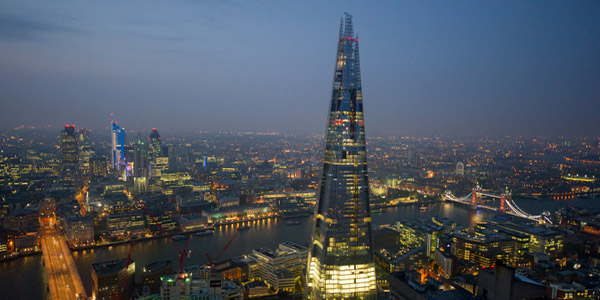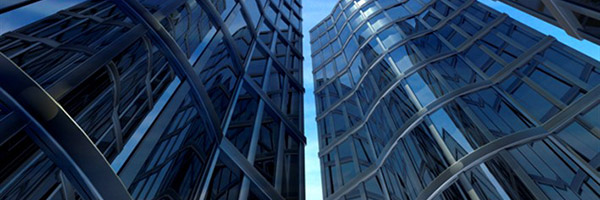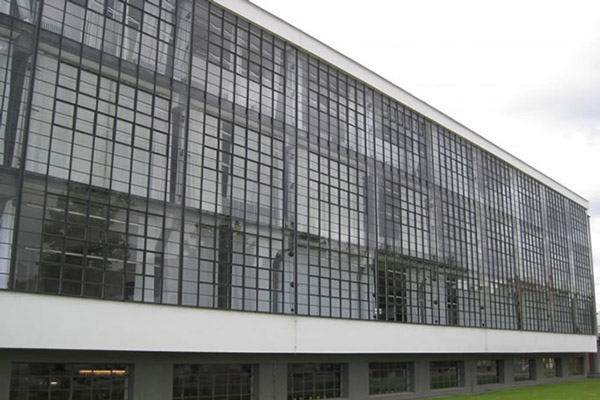Exploring the origins and use of glass in architecture
I was just looking outside of the windows of our living room, from where we can see in the background all the tallest towers in the City, the “Shard”, the “Cheese Grater”, the “Gherkin” and other friends made mainly of glass and steel when my son asked a simple question: how would the City be if glass wasn’t been invented yet?

The Shard, London. Photo by Jason Hawkes
Yes, sometimes parents don’t have the answer and well, sometimes this can be frustrating, like in this case, since I am an architect and I am supposed to know about buildings… then I started to try to think and to look for a possible answer…
Certainly the invention (or better, the discovery) of glass had an incredible influence on how our cities developed in the last 100 years. Probably the architects and artists of the Neue Kunstler Vereingun (the German proto-expressionist movement 1910-1925) were completely right when, in their visionary theory, they believed that actual culture and society wouldn’t even be here if glass had not become a fundamental element in buildings. They believed that that glass architecture radically changed society. The way architectural theories developed afterwards and how the built environment has changed with the use of glass seems to support their beliefs.
What is Glass made of?
In order to try to answer to my son’s simple question I need to start from the basics: What is glass? If you ask Wikipedia

“is a amorphous (non-crystalline) solid material which is often transparent and has widespread practical, technological, and decorative usage in things like window panes, tableware, and optoelectronics…”
but this doesn’t help much…
Glass is composed mainly of Silica (sand) and there are many different types of glasses composed of many different materials to obtain different products with different performances for different uses but I have to make a choice and to reduce the field of the research.
But to go through the process of the glass making helps give a better understanding what glass is.
How is glass made? The Pilkington Process
The glass we are talking about here is window glass, which is mainly made through the float glass process known also as Pilkington process (from the name of the inventor, Alastair Pilkington 1920- 1995). With this process the molten glass flows on the surface of molten metal (tin usually).

Glass manufacturer Pilkington’s glass plant in Russia
The melting stage these days allows the control and refinement of the quality of the glass as desired and, with the float bath, the thickness and the flatness can be very precisely defined.
This process made possible for the first time in the 50’s a continuous and controlled industrial production of building glass, and this changed the face of our towns radically.
The Pilkington process also introduced a few small but fundamental steps which changed fundamentally the way glass is used in buildings:,/p>
Coating, a process where, adding chemical layers on the surface of the glass is possible to modify and control the optical properties of the material.
Annealing, which means, in a nutshell, to control the temperature of the heating and cooling of the glass in a way that allows to avoid the formation of stresses in the material and to improve its homogeneity.

Of course, the entire process is much more complicated and refined than this and I hope that the experts will forgive this rough summary…
A glazed dream
With this process the dream of several generations of architects, from the quoted Neue Kunstler Vereingun through the Bauhaus and Mies Van der Rohe, from Philip Johnson to Renzo Piano, became true.
The architects’ dream about glass buildings started however long before it became possible to produce this material with quality and size that could actualise the dream.
As an example we can look at the famous Bauhaus School’s three storey glazed curtain wall in Dessau which was built in the 20’s (1925-26) and which was surprisingly big at the time. However, if you look closely at the images, the size of each piece of glass was significantly smaller than that which can be achieved these days. The wall was made by framing a lot of small pieces of glass, necessary prior to the invention of float glass.

The glass curtain wall of the Bauhaus School by Walter Gropius, Dessau, Germany. Photo from KSA Digital Library
Most of the glass you see around you today is made in a controlled industrial environment and has to answer to very strict rules in term of Health and Safety, structural performances, U value, and specifications.
It is now possible for designers to select accurately the buildup of the glass based on aesthetic and technical considerations.
Designing with glass
As a designer we are now required to specify in detail:-
The loading capacity of the glass, Safety and breakage requirements Glass coating and visual properties The edge definition
Light transmission value
Reflection and transparency qualities
G value and solar radiations, U value and thermal insulation Acoustic properties
Dimensions, of course
and the list goes on
The accurate definition of all these points can change deeply the look and the performance of a building when made mainly of glass. Still, we architects can actually design the glass and design buildings made entirely of glass with much fewer restrictions than Mies when he designed his Friedichstrasse’s skyscraper.
I know: I am not answering to my son’s question yet! In order to imagine a city without glass I need to immerse in the glass first: I’ll try to re-emerge with some answer with the next chapter.